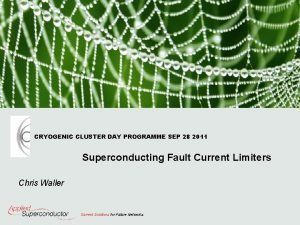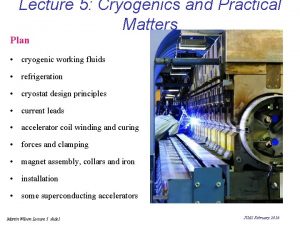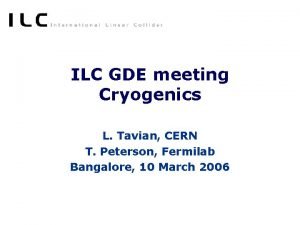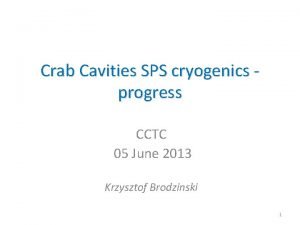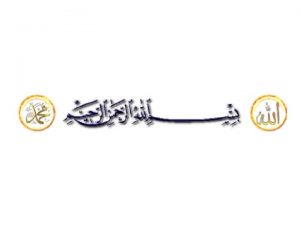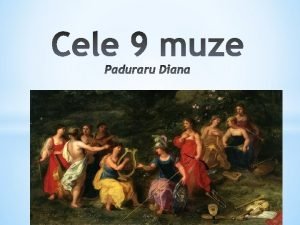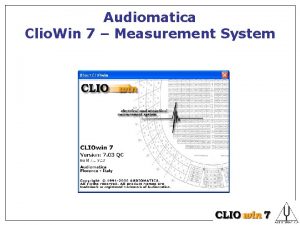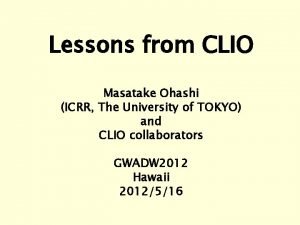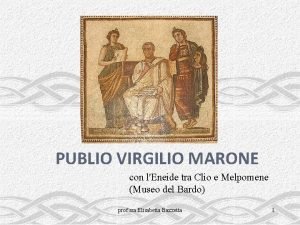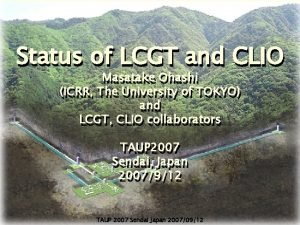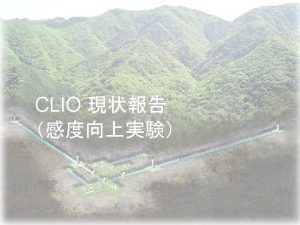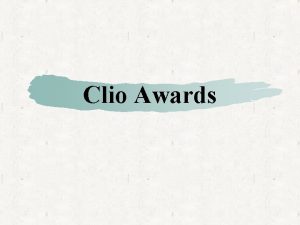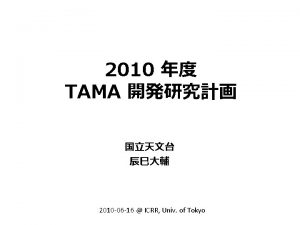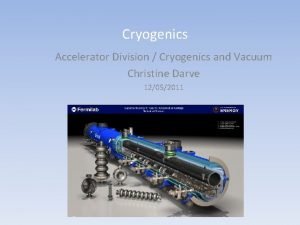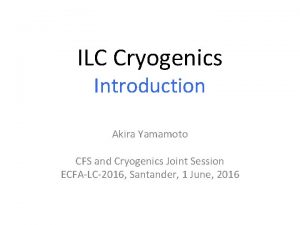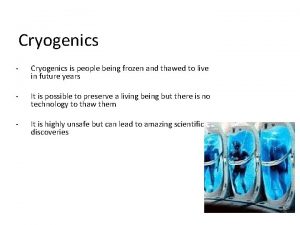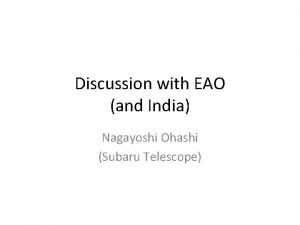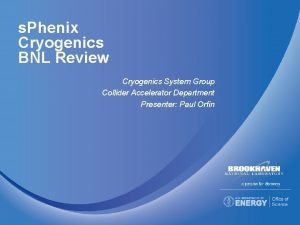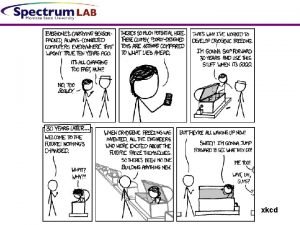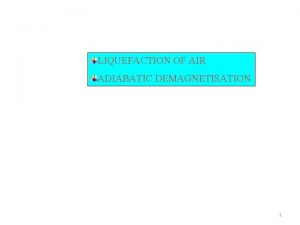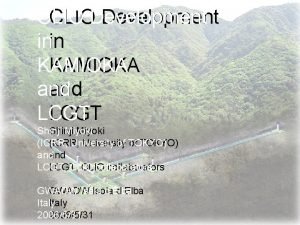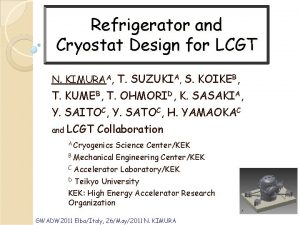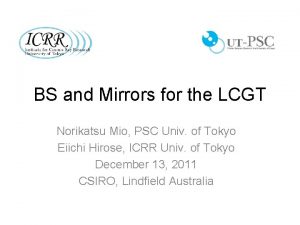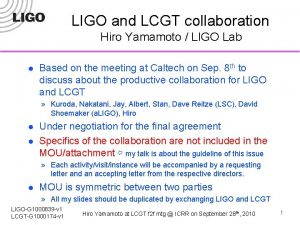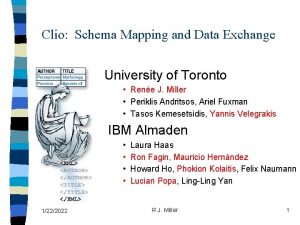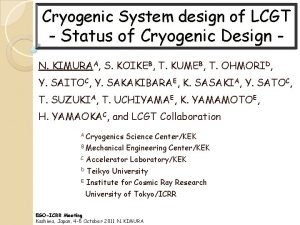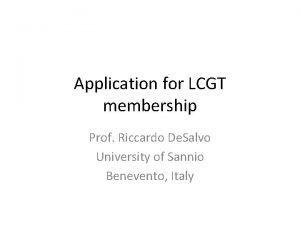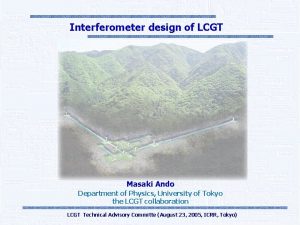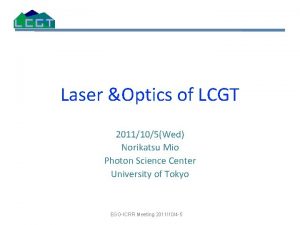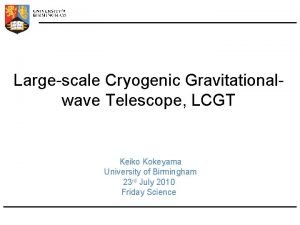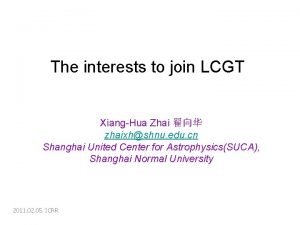Cryogenics in CLIO Masatake Ohashi and the LCGT



































- Slides: 35

Cryogenics in CLIO Masatake Ohashi and the LCGT collaboration ICRR Seminar 2009/07/24

What is CLIO ? CLIO is a cryogenic interferometer with 100 m baseline in the Kamioka Mine. CLIO is a prototype for LCGT. CLIO objective is to demonstrate reduction of thermal noise by mirror cooling. ICRR Seminar 2009/07/24

Illustrated by Dr. Miyoki

Contents • CLIO Outline – Sapphire Mirror – Cryogenic Suspension System – Cryostat and Cooling Technique • Status of CLIO – Present Status as a prototype of LCGT • Summary ICRR Seminar 2009/07/24

Sapphire Mirror ICRR Seminar 2009/07/24

CLIO Sapphire Mirror Substrate: Crystal Systems (US) Polish: CANON (Japan) Coating: JAE (Japan) R=99. 9% Diameter 100 mm Thickness 60 mm (same as TAMA mirrors) ICRR Seminar 2009/07/24

Sapphire Mirror - Absorption of laser light is important factor for mirror cooling. LCGT requirement : substrate 20 ppm/cm (not achieved) coating 1 ppm (OK) We need better quality sapphire substrates. ICRR Seminar 2009/07/24

Sapphire Mirror - Mechanical Quality Factor Measured by Dr. Uchiyama 300 K 20 K Suspended by double sapphire wires Over 108 is obtained at low temperature. ICRR Seminar 2009/07/24

Sapphire Mirror - Dissipation of the Coating film - Loss Angle Measured by Dr. K. Yamamoto Temperature [K] Dissipation seems to be almost independent of Temperature ICRR Seminar 2009/07/24

Cryogenic Techniques ICRR Seminar 2009/07/24

Cryogenic Technique - Estimated Heat Generation in the Mirror substrate : Sapphire Suspension rods : Sapphire Exhaust heat ・ q=290 m. W T=20 K ICRR Seminar 2009/07/24 Safety factor Design

CLIO Cryostat for end mirror ICRR Seminar 2009/07/24

Low vibration Pulse Tube refrigerator developed by KEK and SUMITOMO 58 th Fujihara Seminar 2009/05/28

Cooling test and achieved temperature Several days are necessary for mirror cooling. 63 K 8. 8 K 12. 9 K Measured by Dr. Uchiyama 45 K ICRR Seminar 2009/07/24

300 K Radiation in vacuum pipes 300 K Radiation from inside of vacuum pipes warms mirrors Serious Problem for cooling Mirror (20 K) Radiation shield (40 K) 300 K Radiation ( straying ) Radiation shield, Baffles, … ICRR Seminar 2009/07/24

Radiation Shields (cloistered mirror) Radiation shield for mirrors ICRR Seminar 2009/07/24

Cryogenic suspension system Basic design is double pendulum Intermediate mass Mirror ICRR Seminar 2009/07/24

Cooling method by a cryocooler ICRR Seminar 2009/07/24

Cooling procedure STEP 3 cooling mirror alignment Cooling shortens length of suspension STEP 1 by 2 mm cooling mirror alignment STEP 4 cooling mirror alignment STEP 2 cooling mirror alignment 58 th Fujihara Seminar 2009/05/28

Current status of CLIO ICRR Seminar 2009/07/24

Noise budget at room temperature Thermal noise of suspension Thermal noise of mirror Current sensitivity is limited by thermal noises ICRR Seminar 2009/07/24

Expected Noise Spectrum at 20 K This curve is already realized We started mirror cooling last week. ICRR Seminar 2009/07/24

Today’s DATA One mirror is cooled to 14 K. Preliminary ICRR Seminar 2009/07/24

Gaussian check : Skewness and kurtosis • The Skewness characterizes the degree of asymmetry of a distribution around its mean. Variance : Skewness < 0 Skewness >0 Positively skewed Distribution Negatively skewed Distribution • The Kurtosis measures the relative peakedness or flatness of distribution. Kurtosis : • A distribution with positive Kurtosis is termed leptokurtic. • A distribution with negative Kurtosis is termed platykurtic. • A distribution with 0 Kurtosis is termed mesokurtic. In the case of Gaussian, we expect that the values of Skewness and Kurtosis are 0.

Gaussian check of CLIO DATA

CLIO Data Acquisition Lock Status 2009/4/30 lck unlock JST Data Time

SUMMARY Cryogenic prototype CLIO is in commissioning phase. Cryogenic interferometer is feasible. But we have to improve some points, especially, the combination of heat transfer and vibration isolation is important. ICRR Seminar 2009/07/24








 Cryogenics palm harbor
Cryogenics palm harbor Kirk welding supply
Kirk welding supply What is the difference between 29 028 and 1 312
What is the difference between 29 028 and 1 312 Practical cryogenics
Practical cryogenics Acd cryogenics
Acd cryogenics Sps cryogenics
Sps cryogenics Yorkclio
Yorkclio Namaz clio musun
Namaz clio musun Muza istoriei
Muza istoriei Audiomatica clio
Audiomatica clio Audiomatica clio 12 price
Audiomatica clio 12 price Audiomatica clio 12 price
Audiomatica clio 12 price Clio interlibrary loan management software
Clio interlibrary loan management software Hình ảnh bộ gõ cơ thể búng tay
Hình ảnh bộ gõ cơ thể búng tay Slidetodoc
Slidetodoc Bổ thể
Bổ thể Tỉ lệ cơ thể trẻ em
Tỉ lệ cơ thể trẻ em Chó sói
Chó sói Chụp phim tư thế worms-breton
Chụp phim tư thế worms-breton Alleluia hat len nguoi oi
Alleluia hat len nguoi oi Kể tên các môn thể thao
Kể tên các môn thể thao Thế nào là hệ số cao nhất
Thế nào là hệ số cao nhất Các châu lục và đại dương trên thế giới
Các châu lục và đại dương trên thế giới Công thức tiính động năng
Công thức tiính động năng Trời xanh đây là của chúng ta thể thơ
Trời xanh đây là của chúng ta thể thơ Mật thư tọa độ 5x5
Mật thư tọa độ 5x5 Làm thế nào để 102-1=99
Làm thế nào để 102-1=99 độ dài liên kết
độ dài liên kết Các châu lục và đại dương trên thế giới
Các châu lục và đại dương trên thế giới Thơ thất ngôn tứ tuyệt đường luật
Thơ thất ngôn tứ tuyệt đường luật Quá trình desamine hóa có thể tạo ra
Quá trình desamine hóa có thể tạo ra Một số thể thơ truyền thống
Một số thể thơ truyền thống Bàn tay mà dây bẩn
Bàn tay mà dây bẩn Vẽ hình chiếu vuông góc của vật thể sau
Vẽ hình chiếu vuông góc của vật thể sau Biện pháp chống mỏi cơ
Biện pháp chống mỏi cơ đặc điểm cơ thể của người tối cổ
đặc điểm cơ thể của người tối cổ
